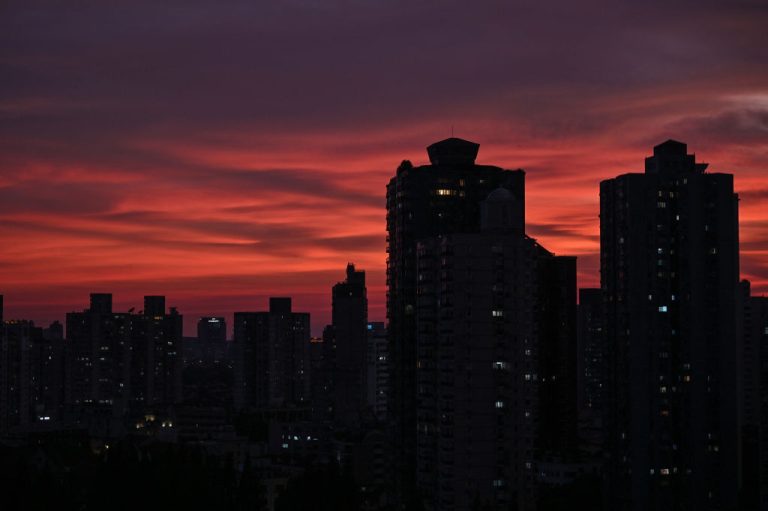Since mid-June, large parts of China have been experiencing extreme weather in the form of unprecedented heat waves and droughts. The scorching temperatures have swept through over 85 cities across the country — affecting more than 600 million people.
According to state media reports, many regions were logging temperatures surpassing 40 degrees Celsius (104 degrees Fahrenheit) in July — which can result in life-threatening heat-stroke.
The large southwestern province of Sichuan has reported “particularly severe” power outages on Aug. 21 after a plan to boost the country’s coal-powered plants and mining sector was postponed to Aug. 25.
MORE ON CHINA’S ENVIRONMENTAL CRISES:
- Scorching Heat Waves Sweep Through 84 Cities in China, Killing Multiple People and Triggering Govt. Power Cuts
- Massive Flooding in China Submerges Roads, Traps Residents Inside Leaking Buildings
- Torrential Downpours Kill Dozens of People in Southern China
Factories closed
Known as the country’s largest hydropower producer, Sichuan authorities warned of a “grave situation,” resulting from a combination of factors related to the heatwaves, low rainfall and “unprecedented demand for electricity.”
“There are severe power shortages because of the extreme high temperature disaster and droughts,” a statement from the authorities said, adding that a “particularly severe” power outage warning had been issued.
Success
You are now signed up for our newsletter
Success
Check your email to complete sign up
As a result, the Sichuan authorities announced the temporary closing of most factories on Aug. 15, and “introduced electricity rationing” in hopes of ensuring sufficient power for domestic usage. Though the measures were supposed to end on Aug. 21, sources from the country’s State Grid told the South China Morning Post (SCMP) that the closures would remain in place in at least some parts of the region.
A bulletin posted on the State Grid’s website in Dazhou — a manufacturing center located in the northern part of the province read: “Industrial power use has not resumed as the focus is still on ensuring [enough for] residential use, although that is being rationed,” adding that, “The resumption of normal supplies depends on the weather. Rain is expected on Aug. 25.”
Demand for power in Sichuan rose by 25 percent this summer, according to state media reports, while water flows feeding into the hydropower reservoirs that provide 80 percent of the province’s electricity fell by more than half.
Many other regions, such as the Xinjiang Basin, central and western Inner Mongolia, Gansu, northeastern Qinghai, Ningxia, Anhui, Jiangsu, Zhejiang and Shanghai, also issued “red and yellow warnings” for high temperatures and potential droughts. On Aug. 21, China’s National Meteorological Center issued 10 consecutive “high temperature red warnings,” — the highest level of alerts in the country.
Shanghai’s Central Meteorological Observatory also issued a “high-temperature red warning” on July 10, and likened the scorching heat waves to have reached life-threatening levels, or so-called, “barbecue mode.” Authorities added on Aug. 22 that decorative lightning in areas around the Bund would be suspended throughout the week in order to “save electricity.”
On Aug. 17, the national meteorological center in Chongqing’s Beibei District logged temperatures reaching over 44.6° C (112.28 ° F), marking the highest recorded temperatures since Chongqing began keeping meteorological records. The city reported on the next day that the heat waves had also resulted in the outbreak of several wildfires across the province.
Most extreme weather since records began
On June 22, Jiyuan City in Henan Province logged a record surface temperature of 74.1° C (165.38 °F). Meanwhile, while temperatures were up in certain northern parts of the country, some places in southern China — including the provinces of Guizhou, Jiangxi, and Guangxi — were reporting record-breaking rainfall, which has resulted in flooding.
The extreme weather patterns have also caused severe drought in several areas — with some Yangtze River tributaries starting to run dry — according to several reports.
On Aug. 6, water levels at the Xingzi measuring point located in Poyang Lake, the largest freshwater lake in the country that connects to the Yangtze River, dropped to 11.99 meters (less than 40 feet) — the lowest levels since modern record-keeping began in 1951.
Meanwhile, water levels for sections of the Yangtze that run through Wuhan city were recorded to have reached 6 meters (less than 20 feet) lower than normal. On Aug. 17, Gu Binjie, an inspector at the Ministry of Water Resources’ (MWR) department of flood and drought disaster prevention, said at a press conference that the Yangtze basin was experiencing “the worst drought” since 1961, according to local reports.
On Aug. 14, the Wuhan local government also imposed “restrictions on commercial power usage,” which would include the shutting down of central cooling and the use of escalators at certain shopping malls and entertainment centers.














